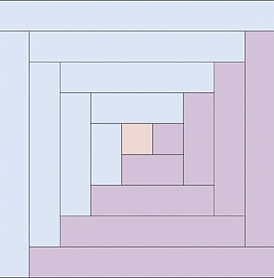
Cabins such as this one used by Harriet Tubman were often the first stop on a
slave's journey to freedom.

Log Cabin Quilting Pattern
You gather up your courage and approach the cabin, keeping an eye out for anything suspicious. The cabin is small and simple, made of wood without any frills. You've heard that these cabins are sometimes used as safehouses, called stations, for fugitives fleeing along the Underground Railroad.
However, cabins such as these are also home to poor white hunters or free black families. You are taking a huge risk; every stranger could be a slave catcher or an informant.
You've overheard rumors that slave catchers remark could more money bringing back one slave than he did in an entire year as a farmer. That makes these people desperate and desperate people are dangerous.
As you peer through the window you notice a fire burning in the hearth. A white man is sitting in a chair with his back to you. There's a candle in the window but it's unlit. There's nothing about this cabin that gives you any clues about who the owner might be and where his sympathies lie about slavery.
Then you notice a quilt hung very prominently on the wall. It looks like an ordinary quilt except for the distinct pattern of interlocking bars, called Log Cabin patterns, that your aunts taught you to recognize. This is a code used by conductors that this was indeed a safehouse. It might still be a trap but you feel confident that it is not.
You knock on the door and are greeted by a white man in his forties with the rough features of a farmer. You begin to doubt your decision until he says, "You have a friend with friends."
You return with Ellen a short while later and the man introduces himself as a Quaker, one of the groups who oppose slavery for religious reasons. He tells you that you are about 10 miles north of Mount Harmon Plantation and that it would be best if you hid in the secret room under the floorboards of the cabin. He explains that this will give you a chance to regain your strength and allow time to pass for the search party to have given up on finding you.
As if on cue, you hear a pack of bloodhounds barking in the distance. No doubt looking for you.
After about two weeks, the shouts of the slave catchers and the barking of the dogs become less frequent. At one point the slave catchers even came to the cabin with the police who forced their way in searching for any "runaway negroes". Safely hidden in a secret cellar, they did not find you.